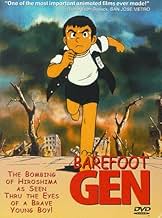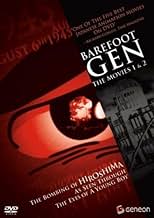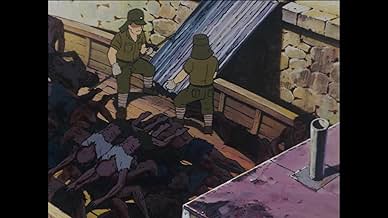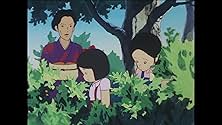VALUTAZIONE IMDb
8,0/10
9829
LA TUA VALUTAZIONE
Segui l'effetto della bomba atomica sulla vita di un ragazzo e sulla vita del popolo giapponese.Segui l'effetto della bomba atomica sulla vita di un ragazzo e sulla vita del popolo giapponese.Segui l'effetto della bomba atomica sulla vita di un ragazzo e sulla vita del popolo giapponese.
- Regia
- Sceneggiatura
- Star
- Premi
- 1 vittoria in totale
Issei Miyazaki
- Gen
- (voce)
Catherine Battistone
- Gen (1995)
- (English version)
- (voce)
Yoshie Shimamura
- Kimie
- (voce)
Iona Morris
- Kimie (1995)
- (English version)
- (voce)
Masaki Kôda
- Shinji
- (voce)
- …
Brianne Brozey
- Shinji (1995)
- (English version)
- (voce)
- (as Brianne Siddal)
Barbara Goodson
- Ryuta (1995)
- (English version)
- (voce)
Takao Inoue
- Daikichi
- (voce)
Kirk Thornton
- Daikichi (1995)
- (English version)
- (voce)
- (as Kurk Thornton)
Seiko Nakano
- Eiko
- (voce)
Wendee Lee
- Eiko (1995)
- (English version)
- (voce)
Takeshi Aono
- Eizo
- (voce)
Michael McConnohie
- Eizo
- (English version)
- (voce)
- (as Amike McConnohie)
- …
Katsuji Mori
- Seiji
- (voce)
Taeko Nakanishi
- Hana
- (voce)
Junji Nishimura
- Pak
- (voce)
Ardwight Chamberlain
- Pak
- (English version)
- (voce)
- …
Recensioni in evidenza
You'll be surprised, this is testimony to the power of 'old style' animation, you need more than Computer Generated images to make a great film. Even with it's basic arrangements barefoot gen managed to shock me by its ability to capture all the horror, confusion and devastation delivered by the atomic bomb.
I found this movie informative but disturbing. I have heard it being described as a tragicomedy. I think this is a fitting description but just be prepared because it really does make giant leaps from the genuinely tragic and sad to light heartedness. You won't know whether to laugh or cry. Actually, you will. A little cry would be totally justified so have a hanky at the ready and don't watch it with your mates from down the pub.
I found this movie informative but disturbing. I have heard it being described as a tragicomedy. I think this is a fitting description but just be prepared because it really does make giant leaps from the genuinely tragic and sad to light heartedness. You won't know whether to laugh or cry. Actually, you will. A little cry would be totally justified so have a hanky at the ready and don't watch it with your mates from down the pub.
Seeing this one at 7 was something to remember. The picture, the sound, the message, the dialogues, the actions. The atomic bombing looked so frightening on a big screen: the people were burning, their flesh – melting, and finally only bones remained.
Some Russian people still recall memories of this cartoon, though, it still has not been officially released in good quality. It must mean something. The animation film was shown decades ago in our theatres and since then has been erased from any means of media - but we still remember it and respect it. "Finding Nemo" is good. "Spirited Away" is better. But this one is a masterpiece that has real history as a background.
Judging by the number of votes, not so many IMDb visitors are aware of this gem. Alas, before making atomic quarrels one should watch this film. You cannot watch it and pass by ignorant.
My mark is a definite 10. Thank you for attention.
Some Russian people still recall memories of this cartoon, though, it still has not been officially released in good quality. It must mean something. The animation film was shown decades ago in our theatres and since then has been erased from any means of media - but we still remember it and respect it. "Finding Nemo" is good. "Spirited Away" is better. But this one is a masterpiece that has real history as a background.
Judging by the number of votes, not so many IMDb visitors are aware of this gem. Alas, before making atomic quarrels one should watch this film. You cannot watch it and pass by ignorant.
My mark is a definite 10. Thank you for attention.
10fabio-46
I have to admit it. I cried, I cried a lot while watching this masterpiece of animation. The horror of the war and the apocalypse of the atomic bomb, engulfed my eyes and my soul so deep inside. It always should be remembered: the first casualty of war is innocence. Hadashi no Gen is a masterpiece, a legacy for the whole humanity. I have read many stories and talked to some survivors from the atomic bombs and I have to say that this movie is the first one that get so poignantly close to what happened on that August, 1945. The only thing I wanted to say at the end of the movie was:"I am sorry, I am sorry that I am human and that I can be so limited...I am sorry..."
Many compare Grave of the Fireflies with Hadashi no Gen/Barefoot Gen. While there are certainly similarities, such as the timeline taking place near the end of the war with Japan, the main difference is that Grave deals mostly with the inhumanity of the Japanese people toward their own kind, while Gen revolves less on this than it does the overall horrors of the after-effects of the nuclear blast at Hiroshima. The hooks used in the respective animes are thus, quite different. While Grave makes one shake their head and wonder about how humanity is sacrificed on the altar of survival and self-centeredness, Gen rests heavily on the outright horror that the dropping of Fat Man unleashed on an entire population.
Animation styles are vastly different also. Grave was made in conjunction with Miyazaki of studio Ghibli (Totoro), and thus was very polished in appearance. Gen, on the other hand, has a mostly "old-fashioned" anime feeling, reminiscent of the "Golden Age of Anime" in the 80's, using devices that are very manga; overblown representations of runny noses and buckets of tears from characters, for example.
In the end, Hadashi no Gen should be on the shelf of every anime collector. When someone says to them that anime is "just for kids", pop this in the VCR and show them just how in-depth, heart wrenching and thought provoking simple pen and ink cells can become. You will have to watch it twice; it's hard to get all the nuances while wiping tears from your eyes.
Animation styles are vastly different also. Grave was made in conjunction with Miyazaki of studio Ghibli (Totoro), and thus was very polished in appearance. Gen, on the other hand, has a mostly "old-fashioned" anime feeling, reminiscent of the "Golden Age of Anime" in the 80's, using devices that are very manga; overblown representations of runny noses and buckets of tears from characters, for example.
In the end, Hadashi no Gen should be on the shelf of every anime collector. When someone says to them that anime is "just for kids", pop this in the VCR and show them just how in-depth, heart wrenching and thought provoking simple pen and ink cells can become. You will have to watch it twice; it's hard to get all the nuances while wiping tears from your eyes.
I've basically pasted this from wikipedia, but since the autobiographical element to this story wasn't mentioned I thought I should post it. There is an interesting article with the artist here http://www.tcj.com/256/i_nakazawa.html (中沢 啓治, Keiji Nakazawa, born 1939) is a Japanese manga artist and writer.
He was born in Hiroshima, and was in the city when it was destroyed by an atomic bomb in 1945. All of his family members who had not been evacuated died in the bombing except for his mother, and an infant sister who died several weeks after the bombing.
In 1961, Nakazawa moved to Tokyo to become a full-time cartoonist, and produced short pieces for manga anthologies such as Shonen Gaho, Shonen King, and Bokura.
In 1966, following the death of his mother, Nakazawa returned to his memories of the destruction of Hiroshima and began to express them in his stories. Kuroi Ame ni Utarete (Struck by Black Rain), the first of a series of five books, was a fictional story of Hiroshima survivors involved in the postwar black market. In 1972, Nakazawa chose to portray his own experience directly in the story "Ore wa Mita" ("I Saw It"), published in Monthly Shonen Jump (In 1982, the story was translated into English and published as a one-shot comic book by Educomics as "I Saw It").
Immediately after finishing "I Saw It", Nakazawa began his major work, Hadashi no Gen (Barefoot Gen). This series, which eventually filled ten volumes (six volumes in English translation), was based on the same events as "I Saw It" but fictionalized, with the young Gen as a stand-in for the author. Barefoot Gen depicted the bombing and its aftermath in graphic detail, but also turned a critical eye on the militarization of Japanese society in the World War II years, and on the sometimes abusive dynamics of the traditional family. Barefoot Gen was made into an animated film, released in 1983. It was followed three years later by a sequel.
He was born in Hiroshima, and was in the city when it was destroyed by an atomic bomb in 1945. All of his family members who had not been evacuated died in the bombing except for his mother, and an infant sister who died several weeks after the bombing.
In 1961, Nakazawa moved to Tokyo to become a full-time cartoonist, and produced short pieces for manga anthologies such as Shonen Gaho, Shonen King, and Bokura.
In 1966, following the death of his mother, Nakazawa returned to his memories of the destruction of Hiroshima and began to express them in his stories. Kuroi Ame ni Utarete (Struck by Black Rain), the first of a series of five books, was a fictional story of Hiroshima survivors involved in the postwar black market. In 1972, Nakazawa chose to portray his own experience directly in the story "Ore wa Mita" ("I Saw It"), published in Monthly Shonen Jump (In 1982, the story was translated into English and published as a one-shot comic book by Educomics as "I Saw It").
Immediately after finishing "I Saw It", Nakazawa began his major work, Hadashi no Gen (Barefoot Gen). This series, which eventually filled ten volumes (six volumes in English translation), was based on the same events as "I Saw It" but fictionalized, with the young Gen as a stand-in for the author. Barefoot Gen depicted the bombing and its aftermath in graphic detail, but also turned a critical eye on the militarization of Japanese society in the World War II years, and on the sometimes abusive dynamics of the traditional family. Barefoot Gen was made into an animated film, released in 1983. It was followed three years later by a sequel.
Lo sapevi?
- QuizThe author of the "Barefoot Gen" manga, Keiji Nakazawa, said that 70% of the story is based on true events from his experience of the atomic bombing of Hiroshima.
- BlooperWhen Gen and Shinji take a big bite from a sweet potato from each end, they are then told by Eiko to give the sweet potato to their mother. Once the sweet potato is given to her, it is whole again.
- Citazioni
Daikichi Nakaoka: This war can't be right. But it's only the cowards like me who dare say it. If there were only a few more like us. You know, sometimes it takes more courage not to fight than to fight, to not want to kill when all around you are calling out for blood. That's real courage in my book. If you boys remember nothing else I teach you, I hope you'll remember that.
- Curiosità sui creditiThe closing credits run horizontally from the left side. Above the credits is footage of a paper boat lantern built sailing past multiple lanterns. After the boat has slowly vanished, the lanterns slowly turn into stars.
- Versioni alternativeThere's a slightly different version of the movie on the website Rumble. Only one change has been applied to it which is the cut to the scene where Kimie (Gen's mom) finds a dead woman on the forest.
- ConnessioniFeatured in Gen di Hiroshima 2 (1986)
I più visti
Accedi per valutare e creare un elenco di titoli salvati per ottenere consigli personalizzati
- How long is Barefoot Gen?Powered by Alexa
Dettagli
Contribuisci a questa pagina
Suggerisci una modifica o aggiungi i contenuti mancanti






























